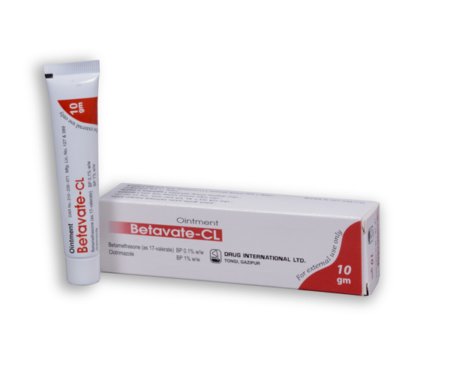
Type:10gm tube
Generic Name:Betamethasone 0.1% + Clotrimazole 1% Topical
Manufacturer:Drug International Ltd.
Price:৳29.00
Tinea pedis, tinea cruris, tinea corporis, ringworm, athlete's foot, jock itch.
Tinea Pedis, Tinea Cruris, & Tinea Corporis Apply to infected area q12hr for 2 weeks for tinea cruris and tinea corporis; 4 weeks for tinea pedis Allergic or Inflammatory Diseases Apply to affected area in the morning and evening
<17 years: Safety and efficacy not established
Patients who are sensitive to clotrimazole, betamethasone dipropionate, other corticosteroids or imidazoles, or to any ingredient in these preparations.
Betamethasone is a corticosteroid with mainly glucocorticoid activity. It prevents and controls inflammation by controlling the rate of protein synthesis, depressing the migration of polymorphonuclear leukocytes and fibroblasts, and reversing capillary permeability and lysosomal stabilisation. Clotrimazole is an antifungal agent that binds to phospholipids in the fungal cell membrane. It causes loss of essential intracellular components by altering cell wall permeability.
Systemic absorption of topical corticosteroids can produce reversible hypothalamic-pituitary-adrenal (HPA) axis suppression with the potential for glucocorticosteroid insufficiency after withdrawal of treatment. Manifestations of Cushing's syndrome, hyperglycemia, and glucosuria can also be produced in some patients by systemic absorption of topical corticosteroids while on treatment. Conditions which augment systemic absorption include use over large surface areas, prolonged use, and use under occlusive dressings. If HPA axis suppression is noted, an attempt should be made to withdraw the drug, to reduce the frequency of application, or to substitute a less potent corticosteroid. Pediatric patients may be more susceptible to systemic toxicity from equivalent doses due to their larger skin surface to body mass ratios Lactation: Excretion in milk unknown; use with caution
1-10% Dry skin (2%),Paresthesia (2%),Local burning (2%) <1% Edema,Rash,Skin atrophy,Secondary infection,Skin ulceration,Acneiform eruption,Bruising,Folliculitis,Striae Clotrimazole Erythema,Stinging,Blistering,Peeling,Edema,Pruritus,Urticaria,General skin irritation Betamethasone Burning,Itching,Irritation,Dryness,Folliculitis,Hypertrichosis,Acneiform eruptions,Hypopigmentation,Perioral dermatitis,Allergic contact dermatitis,Skin maceration,Skin atrophy,Striae,Miliaria,HPA suppression (with higher potency used >2 wk)
Pregnancy There are no available data on topical betamethasone dipropionate or clotrimazole use in pregnant women to identify drug associated risk of major birth defects, miscarriage, or adverse maternal or fetal outcomes; observational studies suggest an increased risk of low birthweight infants with use of potent or very potent topical corticosteroid during pregnancy Advise pregnant women that therapy may increase risk of having a low birthweight infant and to use drug on the smallest area of skin and for shortest duration possible Animal data In an animal reproduction study, betamethasone dipropionate caused malformations (ie, umbilical hernias, cephalocele, and cleft palate) in pregnant rabbits when given by intramuscular route during organogenesis The available data do not allow calculation of relevant comparisons between systemic exposure of clotrimazole and/or betamethasone dipropionate observed in animal studies to systemic exposure that would be expected in humans after topical use of drug Lactation Advise a woman to apply drug to smallest area of skin and for shortest duration possible while breastfeeding; advise breastfeeding women not to apply drug directly to nipple and areola to avoid direct infant exposure